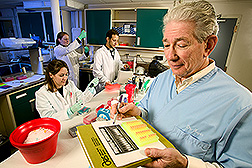Cryptosporidium Clarified in U.S. Cattle
Things aren’t always what they seem.
For Agricultural Research Service zoologist Ronald Fayer, a parasite called Cryptosporidium parvum proved to be the great pretender.
C. parvum is a widespread protozoan parasite, causing debilitating diarrhea in domestic animals, livestock, and humans. The dominant mode of transmission is thought to be contaminated drinking water and recreational waters.
“Testing for Cryptosporidium is based on finding the parasite’s oocysts in fecal matter by microscopic methods,” says Fayer. An oocyst is an egglike stage containing the infectious parasites. Such testing led to the belief that C. parvum was present in all calves.
Delving deeper into the problem, Fayer, biologist James Trout, and postdoctoral scientist Monica Santin, of the Environmental Microbial Safety Laboratory in Beltsville, Maryland, collected data from 15 dairy farms in 7 states to determine the prevalence of Cryptosporidium species in preweaned and postweaned calves. Fecal samples were taken from 971 calves, and 345 were infected with Cryptosporidium. But more preweaned calves (253 of 503) than postweaned calves (92 of 468) were infected. It was apparent that Cryptosporidium wasn’t present in similar levels in preweaned and postweaned calves.
A total of 278 infected specimens, characterized by gene sequencing, revealed C. parvum, C. andersoni, and two unnamed Cryptosporidium genotypes (bovine B and deer-like genotype).
“The prevalence of these Cryptosporidium species and genotypes appeared to be age related,” says Fayer: C. parvum, the only Cryptosporidium species infectious to humans, caused 85 percent of the Cryptosporidium infections in preweaned calves, but only 1 percent in the postweaned calves.
“These findings clearly demonstrate that earlier reports on the presence and prevalence of C. parvum in postweaned cattle, based solely on detecting Cryptosporidium oocysts, must be reassessed using molecular methods to validate species and genotype,” says Fayer.
“Current microscopic testing proves the presence of Cryptosporidium oocysts but doesn’t distinguish between different species.” Using molecular techniques, Fayer and his colleagues found that what was previously thought to be C. parvum in postweaned calves are different species altogether—ones not infectious to humans.
“The major Cryptosporidium species in postweaned calves is actually a species that is limited to cattle and sheep,” says Fayer.
Knowing that the main Cryptosporidium species in postweaned calves isn’t infectious to humans will be a relief to some. “This finding indicates that people handling or otherwise exposed to calves older than 2 months are at less risk of Cryptosporidium infection than those exposed to younger calves,” says Fayer.—By Sharon Durham, Agricultural Research Service Information Staff.
This research is part of Food Safety (Animal and Plant Products), an ARS National Program (#108) described on the World Wide Web at www.nps.ars.usda.gov.
Ronald Fayer is with the USDA-ARS Environmental Microbial Safety Laboratory, 10300 Baltimore Ave., Bldg. 173, Room 100, Beltsville, MD 20705-2350; phone (301) 504-8750, fax (301) 504-6608.
"Cryptosporidium Clarified in U.S. Cattle" was published in the May 2005 issue of Agricultural Research magazine.







